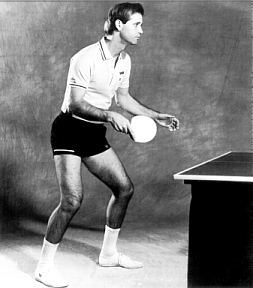|
COMBINING FOREHAND AND BACKHAND
Larry Thoman
Once you are proficient at forehand and backhand block and counter
strokes, it is time to learn how to combine forehand and backhand strokes.
Maintaining a good ready position is the most important aspect of combining
strokes. A good ready position decreases reaction time, permits easy movement in
any direction, and assists in making a smooth, flowing transition from one shot
to the next.
Most of the drills described in this chapter require you to
have good footwork. If you have trouble maintaining consistency when you have to
move your feet, take time out to read Chapter Nineteen Footwork, pages 63-64,
and shadow practice the footwork until you feel comfortable with that kind of
movement.
Lesson 14:
Ready Position
To assume the ready position, look at Photo 13 and keep your:
-
Feet apart, at least shoulder width or wider. Your right
foot is slightly further back than your left foot.
-
Weight on the balls of your feet with the heels slightly
off the ground and your weight evenly distributed on both feet.
-
Arms hanging down with the forearms bent at an approximate
900 angle to the upper arms. This should place the elbows slightly in front
-
Knees bent according to your height. A tall person needs
to bend his knees more than a short person. Avoid standing up straight with your
knees locked.
-
Racket pointed forward, not favoring forehand or backhand.
-
Head tilted up with your eyes focused on the ball.
-
Entire body balanced, relaxed, and in a state of alert readiness.
-
Mind clear, ready to jump start the body into action as soon as ball
speed, spin, and trajectory are perceived.
The basic sequence of a rally is as follows: First, assume the
ready position. Second, judge the trajectory of the ball. Third, move to the
ball. Fourth, stroke the ball. Fifth, return to ready position.
The ready position begins and ends every stroke and every
rally. Practice this by:
(1) assuming the ready position,

Photo 13: Typical Ready Position
(2) taking a quick two-step (refer to Footwork, for an
example of two-step footwork) to the forehand, (3) executing a shadow stroke
forehand counter, (4) taking a two-step back to your original position, and (5)
reassuming the ready position. Repeat this action until it feels comfortable.
The next drill will be to repeat the same drill as in the
preceding paragraph except you add a backhand counter. For this drill you would:
(1) start in the ready position, (2) take a quick two-step to the forehand, (3)
shadow stroke a forehand counter, (4) take a two-step back to your original
position, (5) reassume the ready position, (6) shadow stroke a backhand counter,
and (7) finish by reassuming the ready position once again. As before, repeat
until it feels comfortable.
Lesson 15: Combination Block
Strokes With The Ready Position
To practice forehand and backhand combinations, turn the robot
off and set the sweep control levers to the numbers 2 and 5 positions. The ball
will land from the middle of your forehand court to the middle of your backhand
court.
Assume the ready position just to the left of the center line.
Make sure your racket is pointed straight forward and that the racket and your
forearm align with the center line of the table. Turn the robot on at a slow
speed and frequency and practice a backhand block when the ball lands to the
left of the center line and a forehand block when it lands to the right of the
center line. After each stroke, make sure you assume the ready position before
stroking the next shot. Do one drill in which you place all blocks (both
forehand and backhand) crosscourt, and a second drill where you place all blocks
down-the-line.
Gradually build up your speed, but be careful not to go so
fast that you forget to return to the ready position between strokes. Once you
have reached your upper limits without losing good form, increase the range of
oscillation by changing the sweep control levers to positions 2 and 4, if you're
right handed, and 3 and 5, if you're left handed.
At these settings the ball will land randomly from your
forehand corner to the middle of your backhand court. Repeat the above drills,
but this time move whenever the ball goes to the wide forehand. Again, do one
drill placing all blocks crosscourt, and a second drill placing all blocks
down-the-line. Start at slow ball frequency and build up. Lastly, set the
oscillator to sweep the entire width of the table (sweep control positions 3 &
4) and repeat. Be sure to use a backhand block whenever the ball lands in your
backhand court and a forehand block whenever the ball lands in your forehand
court. Gradually build up ball speed and frequency. Your goal is 50 successful
blocks in a row at each stage.
Lesson 16: Combination
Counter Strokes With The Ready Position
Practice the drills described in the previous lesson, but use
backhand and forehand counters instead of blocks. Then practice the drills using
a backhand counter when the ball lands to the left of center and a forehand
smash when it lands right of center. Remember, whenever you start a new drill,
start slowly, and gradually build up your speed.
The next drill will be to set the robot to deliver balls to
the middle of the backhand court with no oscillation. Practice hitting one
backhand counter and then step out and hit one forehand counter. Keep
alternating between the two strokes, placing the ball crosscourt at first, then
down-the-line. Then practice hitting a backhand counter, followed by a forehand
smash. Again, hit the ball crosscourt at first, then down-the-line. Your goal is
25 successful counter and/or smashes in a row at each stage.
Copyright © Newgy Industries & Larry Thoman.
|